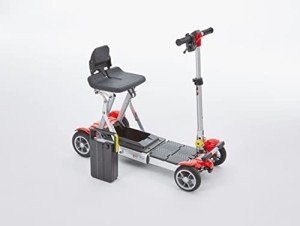10 Strategies To Build Your Lightweight Mobility Scooters Empire
Lightweight Mobility Scooters: A Comprehensive Guide
As the world embraces a more inclusive environment for people with mobility difficulties, lightweight mobility scooters have emerged as vital tools to boost independence and mobility. Created for ease of use, mobility, and an easy to use experience, these scooters provide a useful option for those who wish to browse their surroundings with minimal difficulty. In this short article, we will explore the functions, advantages, and factors to consider included in picking the best lightweight mobility scooter.
What Are Lightweight Mobility Scooters?
Lightweight mobility scooters are compact and quickly transportable electric scooters developed for individuals with minimal mobility. They are normally made from lightweight products such as aluminum and are crafted for ease of disassembly, making it possible for users to take them on public transport or store them in small areas. These scooters offer a practical service for running errands, taking part in recreational activities, or simply delighting in a day out.
Key Features of Lightweight Mobility Scooters
Feature
Description
Weight
Usually weighs in between 30-125 pounds (14-57 kg)
Speed
Maximum speed varies from 4-8 mph (6-13 km/h)
Range
Travel range generally between 10-15 miles (16-24 km) per charge
Turning Radius
Compact turning radius, usually ranging from 32-54 inches (81-137 cm)
Battery Type
Normally utilizes lead-acid or lithium-ion batteries
Seat Options
Swivel and adjustable seat height for comfort
Portability
Developed for simple disassembly and transportation
Weight Capacity
Varies, usually up to 300-400 lbs (136-181 kg)
Accessories
Optional accessories like baskets, lights, or canopies
Advantages of Using Lightweight Mobility Scooters
Enhanced Mobility: Lightweight mobility scooters empower users to move separately, accessing stores, parks, and recreational locations with ease.
Mobility: The capability to dismantle the scooter or fold it makes it easy to transfer in lorries or mass transit.
User-Friendly Design: Most scooters come with user-friendly controls, making them available for individuals of various ages and mobility levels.
Affordable: Compared to bigger, sturdy scooters, lightweight alternatives are typically more economical, making them an attractive option for many users.
Convenience: Many designs have adjustable seating and ergonomic styles to enhance comfort during trips.
Selecting the Right Lightweight Mobility Scooter
When considering the purchase of a lightweight mobility scooter, numerous elements need to be assessed. Below is a list of factors to consider to bear in mind:
Weight and Portability: Evaluate how easy it is to dismantle or fold the scooter for transportation and examine the weight to ensure you can lift it if essential.
Variety and Battery Life: Consider how far you prepare to travel on a single charge and choose a scooter that meets your daily needs.
Weight Capacity: Select a scooter that comfortably supports your weight, making sure stability and toughness.
Comfort and Features: Look for functions like adjustable seating, footrests, and armrests to make sure a comfy experience.
Surface Compatibility: Depending on where you plan to utilize the scooter, think about designs developed for rugged surfaces or primarily for smooth pavements.
Security Features: Ensure there are important safety functions such as lights, reflectors, and a horn to alert pedestrians.
Popular Lightweight Mobility Scooter Models
Design Name
Weight
Speed
Range
Weight Limit
Features
Drive Medical Scout
115 lbs
4.25 mph
15 miles
300 lbs
Swivel seat, adjustable armrests, dismantles easily
Cherokee Mobile
80 lbs
4 miles per hour
10-12 miles
250 lbs
Easy to fold, lightweight, compact design
EV Rider Mini Rider
90 lbs
5 miles per hour
15 miles
300 lbs
Compact style, adjustable tiller, large footrest
Pride Go-Go Elite Traveler
123 pounds
4.5 miles per hour
12.5 miles
300 lbs
4-wheel design, easy disassembly, comfy seat
Upkeep and Care for Lightweight Mobility Scooters
To lengthen the life of a mobility scooter and preserve its performance, follow these maintenance tips:
Regular Cleaning: Keep the scooter clean by wiping it down regularly and preventing exposure to water.
Battery Care: Check the battery monthly for correct charge and clean the terminals to avoid deterioration.
Tire Maintenance: Inspect tire pressure and tread frequently to make sure a safe trip.
Examinations: Schedule routine assessments by a licensed specialist for more innovative monitoring of electrical components.
FAQ Section
1. Are lightweight mobility scooters ideal for outdoor use?
Yes, many lightweight mobility scooters are created for outdoor usage, however it's vital to check the manufacturer's specs for terrain compatibility.
2. Just how much do lightweight mobility scooters cost?
Costs differ based upon functions and specs, typically varying from ₤ 700 to ₤ 2,500.
3. Does Medicare cover mobility scooters?
Medicare might cover the expense of a mobility scooter under particular conditions. It's best to consult with your health care service provider and Medicare for specific protection information.
4. Can I take my mobility scooter on a plane?
A lot of airlines enable mobility scooters as checked baggage; nevertheless, talk to the particular airline company for their policies and treatments.
5. The length of time does the battery last on a lightweight mobility scooter?
A fully charged battery usually lasts anywhere from 10 to 15 miles, depending upon the scooter design and user weight.
Lightweight mobility scooters function as a beacon of independence for those with mobility limitations. With similar web site of models available, it's crucial to choose one that fulfills your specific requirements and preferences. By understanding the features and benefits, users can feel empowered to make informed choices, boosting their mobility and lifestyle. As the market continues to innovate, the future of lightweight mobility scooters is set to become much more user-friendly and encouraging of active way of lives.
